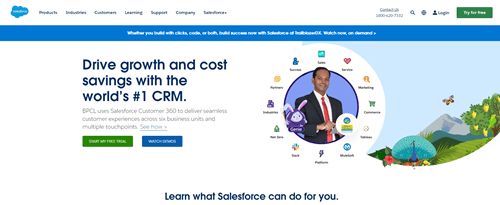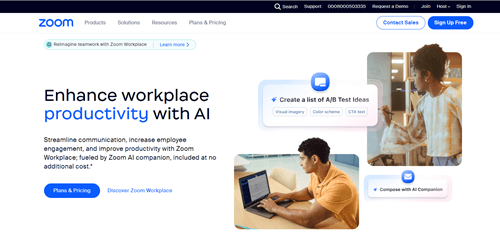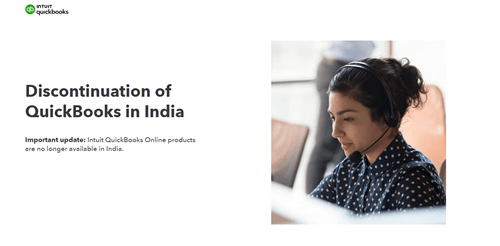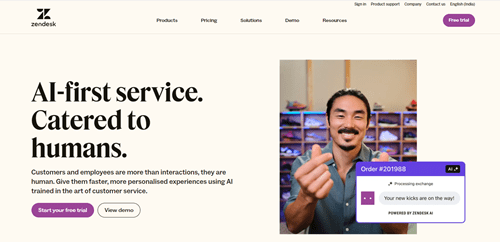
SaaS Business Plan: Your Blueprint for Software as a Service Success
In today’s digital age, the Software as a Service (SaaS) model has emerged as a game-changer, revolutionizing how businesses access and utilize software solutions. By delivering applications over the Internet on a subscription basis, SaaS companies have disrupted traditional software distribution models, offering customers unparalleled flexibility, scalability, and cost-effectiveness. As more companies realize the advantages of the Software as a Service (SaaS) model, creating a thorough and well-considered business strategy, particularly a robust “SaaS Business Plan,” has become crucial for entrepreneurs looking to enter this profitable and rapidly expanding industry.
What is a SaaS Business Plan?
A Software as a Service (SaaS) business plan is a strategic document that acts as a road map for starting and growing a profitable SaaS firm. A SaaS business plan, in contrast to a regular one, is made expressly to tackle the special opportunities and problems that the SaaS model presents. This all-inclusive road map describes the goals, strategies, and doable actions required to successfully navigate the challenges of developing a successful SaaS business.
A software-as-a-service (SaaS) business plan comprises several essential components: market studies, pricing models, product development methods, marketing and sales tactics, financial predictions, and operational plans. Entrepreneurs who carefully manage each of these areas can better communicate their ideas, recognize possible risks and obstacles, and create practical plans to reduce them.
How Do I Create a SaaS Business Plan?
Creating a compelling SaaS business plan requires a deep understanding of the market, a clear value proposition, and a well-defined execution strategy. Here are the key steps to follow:
Conduct Thorough Market Research and Competitor Analysis:
- Gather insights into the target market, customer needs, and industry trends.
- Identify the pain points your SaaS solution aims to address and validate the demand for your offering.
- Analyze your competitors’ strengths, weaknesses, and strategies to identify opportunities for differentiation.
Define Your Unique Value Proposition and Target Customer Segments:
- Clearly state the distinct value that your SaaS solution offers to clients.
- Highlight the features, benefits, and competitive advantages that set your solution apart.
- Identify and define your ideal customer personas based on demographics, psychographics, and behavior patterns.
Outline Your Product Roadmap, Including Features, Integrations, and Scalability Plans:
- Develop a comprehensive plan for your product’s evolution, including new features, enhancements, and integrations with other platforms or services.
- Address scalability considerations, ensuring your product can handle increasing user demand and data volumes without compromising performance.
- Outline your approach to continuous improvement, incorporating user feedback and industry trends.
Develop a Pricing Strategy and Explore Revenue Streams:
- Determine your pricing model, considering the value proposition, target market, competitive landscape, and customer willingness to pay.
- Explore different revenue streams, such as subscriptions, add-ons, professional services, or premium features.
- Outline strategies for upselling, cross-selling, and maximizing customer lifetime value (CLV).
Build a Comprehensive Marketing and Sales Plan:
- Create a strong marketing strategy to reach and engage your target audience effectively.
- Outline your sales process, including lead generation tactics, conversion strategies, and customer retention efforts.
- Leverage various marketing channels, such as content marketing, social media, email campaigns, and partnerships.
Provide Detailed Financial Projections:
- Create revenue projections based on your pricing strategy, target market size, and customer acquisition goals.
- Estimate costs, including development, marketing, sales, and operational expenses.
- Conducted cash flow analyses and identified potential funding sources and investment requirements.
- Set realistic financial milestones and benchmarks to measure success.
Address Operational Aspects and Legal Considerations:
- Outline your organizational structure, key personnel, and operational processes.
- Address infrastructure requirements, security measures, and compliance with relevant regulations and industry standards.
- Ensure proper intellectual property protection for your Software and brand.
- Discuss legal aspects such as software licensing agreements, data privacy, and terms of service.
Why is SaaS Popular for Business Plans?
The SaaS model has gained immense popularity for business plans due to its inherent advantages and the growing demand for cloud-based solutions. Here are some key reasons why SaaS is a compelling choice:
Recurring Revenue Model:
- SaaS businesses generate predictable, recurring revenue streams through subscriptions, enabling long-term growth and sustainability.
- This model provides a more stable and reliable source of income compared to traditional one-time software purchases.
- Recurring revenue allows for better financial forecasting and enables reinvestment in product development and customer support.
Lower Upfront Costs for Customers:
- Customers can access Software without substantial upfront hardware, installation, or maintenance investments.
- This lower barrier to entry increases affordability and accessibility, especially for small and medium-sized businesses.
- The SaaS model allows customers to scale their usage and costs as their needs evolve, providing flexibility and cost-effectiveness.
Scalability and Flexibility:
- SaaS solutions facilitate cost-effective resource usage and optimization by quickly scaling up or down in response to customer needs.
- Providers can rapidly provision or de-provision resources to meet fluctuating demand, ensuring optimal performance and resource allocation.
- Due to its scalability, businesses can swiftly adjust to shifting market conditions or expansion prospects.
Continuous Updates and Innovation:
- SaaS providers can seamlessly deliver customers software updates and new features without complex installations or upgrades.
- Customers will always have access to the most recent version of the program thanks to this continuous enhancement process, which boosts competitiveness and efficiency.
- Additionally, SaaS companies can rapidly iterate and innovate based on customer feedback and market trends.
Understanding the SaaS Business Model
To succeed in the SaaS market, it’s crucial to comprehend the unique business model that underpins this approach. Key aspects of the SaaS business model include:
Subscription-Based Pricing:
- Customers pay a recurring charge to access the Software and its capabilities once a month or once a year.
- This pricing model provides a predictable and recurring revenue stream for the SaaS provider.
- Subscriptions can be based on various factors, such as the number of users, feature sets, or usage metrics.
Multi-Tenancy:
- A single instance of the Software serves multiple clients concurrently, guaranteeing effective resource usage and cost reduction.
- This multi-tenant architecture allows for scalability and rapid provisioning of resources based on demand.
- However, it introduces data segregation, security, and performance management challenges.
Remote Hosting and Delivery:
- The Software and customer data are hosted on the provider’s servers or cloud infrastructure, eliminating the need for on-premises infrastructure.
- Clients use specialized apps or web browsers to access the Software online.
- This approach simplifies deployment, maintenance, and updates, as the provider manages the infrastructure and software stack.
Scalable Architecture:
- As demand changes, adding or removing resources may be done easily with SaaS services because they are built to be scalable.
- This scalable architecture leverages virtualization, containerization, and auto-scaling technologies for optimal performance and resource allocation.
- Providers must continuously monitor and manage system resources to maintain high availability and responsiveness.
Top Key Metrics of SaaS Businesses
Key metrics are commonly tracked and analyzed to measure a SaaS business’s success and growth. These metrics provide valuable insights into the performance of the Business and help identify areas for improvement or optimization. Here are some of the top key metrics for SaaS businesses:
Monthly Recurring Revenue (MRR):
- MRR represents the predictable, recurring revenue generated from active subscriptions every month.
- It is calculated by summing up the monthly subscription fees from all active customers.
- MRR is a crucial indicator for SaaS companies since it shows how well the Business can produce consistent, recurring revenue.
Customer Acquisition Cost (CAC):
- This metric calculates the total cost of gaining a new client, considering sales, marketing, and other relevant costs.
- It is calculated by dividing the total acquisition costs by the number of new customers acquired during a specific period.
- Optimizing CAC is essential for SaaS businesses to ensure profitability and sustainable growth.
Customer Lifetime Value (CLV):
- CLV represents a customer’s projected revenue over their lifetime with the SaaS product or service.
- It is calculated by considering factors such as average subscription length, revenue per customer, and customer churn rate.
- A high CLV relative to CAC indicates a sustainable and profitable business model.
- SaaS businesses strive to maximize CLV through customer retention strategies, upselling, and cross-selling efforts.
Churn Rate:
- The percentage of consumers that cancel or forget to renew their memberships within a specified time frame—usually monthly or annually—is known as the churn rate.
- It is computed by taking the total number of consumers at the beginning of a period and dividing it by the number of customers lost over that period.
- SaaS companies concentrate on reducing churn through customer success programs and product enhancements. A high churn rate can substantially negatively influence revenue growth and profitability.
Monthly Active Users (MAU):
- MAU represents the number of unique users actively engaging with the SaaS product each month.
- It provides insights into product adoption, usage patterns, and potential areas for growth or optimization.
- Tracking MAU can help identify opportunities for user engagement, feature enhancements, or targeted marketing campaigns.
Net Revenue Retention (NRR):
- NRR measures a SaaS company’s ability to retain and grow revenue from existing customers through upsells, cross-sells, and renewals.
- It is computed by dividing the total income from current clients at the beginning of the period by their total revenue after the term.
- An NRR greater than 100% indicates that the company is successfully expanding its revenue from existing customers, a key growth driver for SaaS businesses.
Steps to Create a Comprehensive SaaS Business Plan
To create a comprehensive SaaS business plan that serves as a roadmap for success, entrepreneurs should follow these key steps:
Executive Summary:
Mission, Value Proposition, and Objectives:
- Clearly articulate the mission of the SaaS business, focusing on the problem it solves and the value it delivers to customers.
- Emphasize the special selling point that makes your SaaS stand out.
- Define specific objectives aligned with the mission, such as market penetration, revenue targets, or user acquisition goals.
Market Opportunity and Target Customers:
- Provide insights into the size and growth potential of the target market, supported by data and market research.
- Divide the target market into segments according to behavioral traits, psychographics, or demographics.
- Identify the primary pain points or challenges your target customers face that your SaaS solution addresses.
Competitive Advantages and Team Expertise:
- Showcase your SaaS’s competitive advantages, such as innovative technology, unique features, or superior customer service.
- Highlight the expertise and experience of your team members, emphasizing their relevant skills, qualifications, and accomplishments.
- Illustrate how the combination of your unique offering and talented team positions your SaaS for success in the marketplace.
Market Analysis:
Trends in the Industry and Market Research:
- Conduct in-depth market research to comprehend market dynamics, new opportunities, and industry trends.
- Analyze competitor strategies, market positioning, and product offerings to identify gaps and areas for differentiation.
- Monitor technological advancements, regulatory changes, and macroeconomic factors that impact the industry.
Market Size and Growth Potential:
- To determine the SaaS solution’s total addressable market (TAM), consider customer segments, industry verticals, and geography variables.
- Forecast the expected market growth rate based on historical data, industry forecasts, and expert insights.
- Identify niche markets or underserved segments within the broader market landscape.
Customer Segments and Buying Behaviors:
- Define distinct customer segments based on criteria such as industry, company size, or user personas.
- Analyze each customer segment’s buying behaviors and decision-making processes, including factors influencing purchasing decisions.
- Ensure your sales and marketing tactics meet every consumer group’s requirements and tastes.
Product and Service Description:
Features and Benefits:
- Give a thorough rundown of the features and functionalities of your SaaS product or service, focusing on how they solve problems for customers and create value.
- Highlight any unique or innovative features that differentiate your offering from competitors.
- Illustrate the specific benefits users can expect from using your SaaS solution, such as increased efficiency, cost savings, or improved productivity.
Technology Stack and Scalability:
- Describe the underlying technology stack powering your SaaS platform, including programming languages, frameworks, databases, and infrastructure components.
- Discuss scalability considerations, such as architecture design, server infrastructure, and capacity planning, to accommodate future growth and increased user demand.
- Address any technical challenges or limitations associated with scalability and outline your plans to overcome them.
Product Roadmap and Future Enhancements:
- Outline your product roadmap, detailing upcoming features, enhancements, and functionalities planned for future releases.
- Solicit customer, stakeholder, and industry expert feedback to inform your product development priorities and roadmap.
- Highlight any strategic partnerships, integrations, or expansions that may influence your product roadmap and business trajectory.
Marketing and Sales Strategy:
Marketing Plan and Audience Engagement:
- Create a thorough marketing strategy that details your approaches to drawing in, involving, and keeping consumers.
- Determine which marketing strategies and channels—content marketing, social media, email campaigns, SEO, SEM, and events—will best reach your target market.
- Establish key performance indicators (KPIs) to gauge the success of your marketing campaigns and monitor your advancement toward your objectives.
Sales Process and Customer Acquisition:
- Draw out your sales process, including the duties and responsibilities of your sales team members at each stage, from lead generation to conversion.
- Implement lead generation tactics to fill the sales pipeline, such as inbound marketing, outbound prospecting, networking, and referral programs.
- Develop strategies for qualifying leads, nurturing prospects, overcoming objections, and closing deals to maximize conversion rates and revenue.
Pricing Strategy and Revenue Optimization:
- Based on variables including competition price, value-based pricing, and pricing psychology, decide on your pricing approach.
- Offer flexible pricing plans and packages tailored to customer segments, usage levels, and budget constraints.
- Incorporate pricing experiments, A/B testing, and customer feedback to optimize pricing strategy and maximize revenue generation.
Operations and Management:
Organizational Structure and Personnel:
- Define the organizational structure of your SaaS company, including departments, teams, and reporting relationships.
- Describe the positions and duties of important staff members, such as the founders, executives, managers, and individual contributors.
- Emphasize the importance of building a diverse and inclusive team that reflects the values and culture of your organization.
Infrastructure Requirements and Compliance:
- Assess the infrastructure requirements for your SaaS platform, including hosting, security, data storage, and compliance.
- Adopt best practices for privacy, data security, and compliance with pertinent laws and regulations, including PCI DSS, GDPR, HIPAA, and SOC 2.
- Regularly audit and update your infrastructure to address evolving security threats, compliance requirements, and technology advancements.
Customer Support and Service Delivery:
- Develop a customer support strategy that meets the needs and expectations of your target customers, offering multiple channels for assistance and issue resolution.
- Provide resources, documentation, and training materials to help customers get the most out of your SaaS product or service.
- Maintain a constant eye on customer happiness, comments, and support data to spot problem areas and promote operational excellence.
Financial Projections:
Revenue Forecasts and Cost Estimation:
- Project your revenue streams based on your pricing model, market size, customer acquisition strategy, and growth projections.
- Estimate the costs of developing, marketing, selling, and supporting your SaaS product or service, including fixed and variable expenses.
- Do sensitivity studies and scenario planning to determine how various assumptions and factors affect your financial projections.
Cash Flow Management and Funding Requirements:
- Create a cash flow forecast to track inflows and outflows of cash over time, identifying potential cash flow gaps or surpluses.
- Evaluate your funding requirements based on your projected cash flow needs, investment opportunities, and capital expenditures.
- To meet your financing needs, explore different funding sources, including bootstrapping, angel investors, venture capital, bank loans, and crowdfunding.
Risk Assessment and Mitigation:
Identification of Risks and Challenges:
- Determine the risks and uncertainties your SaaS business may face, including market competition, technological disruptions, regulation changes, and economic downturns.
- Evaluate each risk’s possibility and consequences, classifying them according to controllability and seriousness.
Strategies for Risk Mitigation:
- Create preemptive strategies and backup plans to reduce the impact of identified risks and obstacles on your Business’s performance and operations.
- Implement risk management processes and controls to promptly monitor, mitigate, and respond to emerging risks.
- Maintain open communication channels with stakeholders, investors, and partners to inform them about potential risks and mitigation efforts.
By following these steps and creating a comprehensive SaaS business plan, entrepreneurs can increase their chances of success in the competitive SaaS market. A well-crafted plan not only serves as a roadmap for execution but also demonstrates the Business’s viability and can be a powerful tool for securing funding, attracting talent, and maintaining focus on long-term goals.
Best SaaS Software Example
Salesforce (CRM)

Industry:
Customer Relationship Management (CRM)
Key Features:
Contact management, lead tracking, opportunity management, sales forecasting, workflow automation, reporting, and analytics.
Benefits:
Centralized customer data, improved sales productivity, better collaboration, and insights for data-driven decision-making.
Limitations:
The steep learning curve, expensive for small businesses, and limited customization options without additional costs.
Pricing Plan:
Essentials ($25/user/month), Professional ($75/user/month), Enterprise ($150/user/month), Unlimited ($300/user/month).
HubSpot (Marketing Automation)

Industry:
Inbound Marketing, Sales, and CRM
Key Features:
Website builder, landing pages, email marketing, lead management, analytics, and CRM integration.
Benefits:
Streamlined marketing and sales processes, better lead generation, and nurturing improved customer experiences.
Limitations:
There is limited functionality in the free plan; some advanced features require additional costs.
Pricing Plan: Free, Starter ($50/month), Professional ($890/month), Enterprise ($3,200/month).
Slack (Team Communication)

Industry:
Collaboration and Communication
Key Features:
Messaging, file sharing, voice and video calls, integrations, and workflow automation.
Benefits:
Improved team communication, centralized information sharing, increased productivity, and seamless collaboration.
Limitations:
The free plan has limited storage and message history, potential distractions, and information overload.
Pricing Plan:
Free, Standard ($8/user/month), Plus ($15/user/month), Enterprise (Custom pricing).
Dropbox (Cloud Storage)

Industry:
Cloud Storage and File Sharing
Key Features:
File storage, syncing, sharing, collaboration, and version control.
Benefits:
Easy access to files from anywhere, secure backup, and seamless document collaboration.
Limitations:
Limited free storage, potential security concerns with sensitive data, bandwidth limitations.
Pricing Plan:
Basic (Free, 2GB), Plus ($11.99/month, 2TB), Family ($19.98/month, 6TB), Professional ($19.99/user/month, 3TB).
Zoom (Video Conferencing)

Industry:
Video Communications
Key Features:
High-definition video conferencing, screen sharing, recording, virtual backgrounds, and integrations.
Benefits:
Reliable and secure video meetings, improved collaboration and communication, and cost-effective for remote teams.
Limitations:
Limited meeting duration, participant limits in the free plan, and potential security and privacy concerns.
Pricing Plan:
Basic (Free), Pro ($149.90/year), Business ($199.90/year/license), Enterprise ($199.90/year/license).
Quickbooks (Accounting Software)

Industry:
Accounting and Bookkeeping
Key Features:
Invoicing, expense tracking, payroll management, tax calculations, financial reporting, and bank connectivity.
Benefits:
Streamlined accounting processes, better financial management, time-saving automation, and improved accuracy.
Limitations:
The basic plans offer limited functionality, a steep learning curve for complex features, and potential compatibility issues.
Pricing Plan:
Simple Start ($25/month), Essentials ($40/month), Plus ($70/month), Advanced ($180/month).
Trello (Project Management)

Industry:
Project Management and Task Tracking
Key Features:
Kanban boards, task management, team collaboration, file attachments, and integrations.
Benefits:
Visual project management, improved team coordination, task prioritization, and productivity tracking.
Limitations:
The free plan has fewer advanced features and potential information overload with complex projects.
Pricing Plan:
Free, Business Class ($10/user/month), Enterprise ($17.50/user/month).
Grammarly (Writing Assistant)

Industry:
Writing and Editing
Key Features:
Grammar checking, spelling correction, plagiarism detection, style suggestions, and tone adjustments.
Benefits:
Improved writing quality, consistent tone and style, time-saving editing, and increased productivity.
Limitations:
Limited functionality in the free version, potential privacy concerns with document uploading.
Pricing Plan:
Free, Premium ($12/month), Business ($12.50/user/month).
Asana (Work Management)

Industry:
Project Management and Task Tracking
Key Features:
Task management, project portfolios, calendars, timeline views, reporting, and integrations.
Benefits:
Centralized work management, improved team collaboration, better project visibility, and streamlined workflows.
Limitations:
The steep learning curve for advanced features potential information overload with complex projects.
Pricing Plan:
Basic (Free), Premium ($10.99/user/month), Business ($24.99/user/month), Enterprise (Custom pricing).
Zendesk (Customer Support)

Industry:
Customer Service and Support
Key Features:
Ticketing system, knowledge base, live chat, call center software, and customer analytics.
Benefits:
Efficient customer support, improved response times, better self-service options, and insights for continuous improvement.
Limitations:
Limited functionality in the lower-tier plans and potential integration challenges with existing systems.
Pricing Plan:
Suite Team ($49/agent/month), Suite Growth ($79/agent/month), Suite Professional ($99/agent/month), Enterprise (Custom pricing).
FAQs
What is the difference between a SaaS business plan and a traditional one?
A SaaS business plan focuses specifically on the unique aspects of the Software as a Service model, including recurring revenue streams, scalability, and continuous updates. In contrast, a traditional business plan is more general and may not address the nuances of the SaaS business model.
How do I determine the right pricing strategy for my SaaS product?
Consider factors such as the value proposition, target market, competitive landscape, and pricing models similar to SaaS products. Strategies like freemium, tiered pricing, usage-based pricing, or value-based pricing may be viable options. Conduct market research and testing to identify the most effective pricing strategy.
What are some common challenges faced by SaaS businesses?
Common challenges include customer acquisition and retention, managing churn rates, scalability issues, security and compliance concerns, and the need for continuous innovation and feature updates. Additionally, SaaS businesses must navigate the complexities of multi-tenancy, data segregation, and performance optimization.
How do I ensure my SaaS business plan remains relevant and up-to-date?
Regularly review and update your business plan to reflect changes in the market, customer needs, technological advancements, and your company’s growth and evolution. Incorporate feedback from customers, employees, and industry experts to ensure your plan remains aligned with reality.
Can a SaaS business plan be used to secure funding or investments?
Obtaining funds from lenders, venture capitalists, or investors requires a strong SaaS business plan. It proves your company’s strength, knowledge of the industry, and capacity to carry out your plan efficiently. A well-thought-out plan will improve your chances of obtaining the funding required for development and expansion.
Which legal and regulatory factors are most important for a SaaS company?
Consider data privacy and security regulations (e.g., GDPR, CCPA, HIPAA), intellectual property protection, software licensing agreements, and industry-specific compliance requirements. AdditIt also addresses service terms level agreements (SLAs), customer data ownership, and portability issues.
Conclusion
In conclusion, a well-thought-out SaaS business plan is the cornerstone of success in the ever-evolving tech landscape. By meticulously outlining your goals, target market, pricing strategy, and growth tactics, you pave the way for sustainable growth and profitability. Adaptability and continuous refinement are key as you navigate the dynamic world of Software as a service. Beyond the initial planning stage, regularly revisiting and adjusting your plan based on market feedback, technological advancements, and competitive analysis ensures your Business remains agile and responsive. With a solid plan in hand, supported by ongoing iteration and optimization, you’re poised to seize opportunities, overcome challenges, and propel your SaaS venture to new heights of achievement.




